Before their procedures, many of our patients share with us how nervous they feel about their upcoming endoscopy or colonoscopy. The following section will help you understand what to expect on the day of your procedure, and hopefully, help to put your mind at ease.
Arrival and Check In
We require that someone accompany you to (and from) the Endoscopy Center on the day of your procedure. When you arrive, you must have the following items with you to check in:
- your driver’s license or ID
- your insurance card
- your co-pay or facility payment (if any), payable by cash, check, Visa or MasterCard
- your completed Medication List
All other (personal) items may be left at home or with the person who accompanied you to the center.
In The Admitting Room
After check in, a nurse will bring you into a private admitting room. We will go over your completed Medication List, to ensure that we can safely administer a sedative during the procedure without any drug interactions or duplications. You will change into a hospital gown, and we will start your IV.
When you are ready, we will take you into a procedure room and the anesthesiologist will begin administering a sedative to help you rest comfortably. Most commonly, patients opt for propofol anesthesia, a sedative that produces a deep sleep and a quick recovery. For patients with a medical history that precludes them from receiving anesthesia, "conscious sedation" is available as an alternative.
Anesthesia
When you are ready, we will take you into a procedure room and the anesthesiologist will begin administering a sedative to help you rest comfortably. Most commonly, patients opt for propofol anesthesia, a sedative that produces a deep sleep and a quick recovery. For patients with a medical history that precludes them from receiving anesthesia, "conscious sedation" is available as an alternative.
The Procedure
The procedure itself may take anywhere from 15 minutes to one hour. During that time, your physician will inspect your gastrointestinal lining, looking for polyps, growths, or signs of infection/inflammation. If you are having an upper endoscopy, the focus will be on your esophagus, stomach and beginning of the small intestine. If you are having a colonoscopy, the focus will be on your large intestine or colon.
Both procedures use a long tube (or "scope") that can be manipulated by the physician to capture images along your GI tract, take tissue samples, or remove growths. If any polyps are found, your gastroenterologist will remove them during the procedure and send them to the pathology lab for analysis.
In The Recovery Room
After the procedure, you will be wheeled into a private recovery room where it may take 20 to 30 minutes for you to fully wake up from the anesthesia. When you are alert, your gastroenterologist will come in to discuss what happened during the procedure. A nurse will review your discharge instructions with you, including restrictions on diet, activity-level, driving, and medications. You will be given a copy of your discharge instructions to take home, as well as a 24-hour emergency phone number to call if you feel unwell after the procedure. A follow up appointment will also be provided for you.
Going Home
For your safety, we will not discharge you from the Endoscopy Center unless someone is available to drive you home. If you are taking a taxi or public transportation, you must have someone responsible to accompany you. You will not be allowed to drive or work for the remainder of the day, so plan to use that time for rest and relaxation at home instead.
If You Need To Cancel An Appointment
Please note that we require 48-hour notice to cancel a procedure. This allows us to offer your procedure slot to someone who may need to be seen urgently (and provides an appropriate amount of time for them to complete the prep).
Patients who miss a procedure (or cancel a procedure with less than 48-hours notice) will be charged a $50 missed appointment fee, and patients who repeatedly miss appointments will be referred out of our practice.

